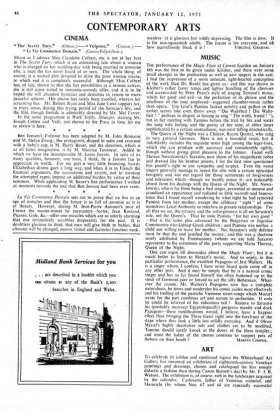ART
To celebrate its jubilee and continued vigour the Whitechapel Art Gallery has mounted an exhibition of eighteenth-century Venetian paintings and drawings, chosen and catalogued (in less smugly didactic a fashion than during Canon Barnett's day) by Mr. F. J. B. Watson. The exhibition is, of course, rich in the landscapes acquired by the milordos. Carlevaris. father of Venetian vedutisti, and Marieschi (by whom Nos. 67 and 68 are especially successful examples) have perhaps been too completely overshadowed by Canaletto and Guardi respectively. The latter were neither of them invited by Tiepolo to join the reconstituted Venetian Academy in the middle of the century, and faced with Canaletto at his most artisan—in such a picture, say, as No. 8, where the size is out of all proportion to the content--one can scarcely consider this an injustice. But then, to make one reconsider, comes a small masterpiece like the "View on a River" (probably the Brenta). The view of Westminster Bridge and the procession of the Knights of the Bath from West- minster Abbey are among the more pleasing of his English land- scapes. While Canaletto supplied the Grand Tourists with implications of permanence, Guardi's souvenirs have all the poignancy of Venice in decline. The cloth hanging heavily from the balustrade, the statues crumbling against the sky, the long shadows and the perspectives which reach through the long arcades, across the paved piazzas, are blocked, turned twisted until finally released over the stagnant waters—these are now a commonplace, but by them Guardi caught something of the halucinatory significance that haunts Venice still.
The decorative pairders are less easily represented from domestic sources (though Sebastiano and Marco Ricci both visited England with an eye to the job of decorating St. Paul's), but there are a number of excellent Tiepolo sketches, drawings and etchings. A series of fourteen drawings by G. D. Tiepolo, of the adventures of Pulchinello, are of interest, as are, inversely so to speak, Rosalba's insipid pastel heads. Perhaps the most remarkable portraits are in the unfinished sketch of the Tiepolo family group. This is cata- logued as by Pietro Longhi, but is so greatly superior to most of his work that one cannot but wonder. . . . In March the exhibition goes to Birmingham.
At the New Burlington Galleries the Arts Council are showing a small number of nineteenth-century French paintings from the Burrell collection— a very much wider selection from which was seen in Glasgow in 1949. This is remarkable, apart from such well- known masterpieces as Degas's "Adage," and Ckzanne's frontal attack on Zola's house at Medan, for some pleasing Boudins, oils large and small by Daumier (of which the smaller are the more seemly), Maners plate of ham and a small panel of a " Shepherdess"
by Millet. M. H. MIDDLETON.



































 Previous page
Previous page